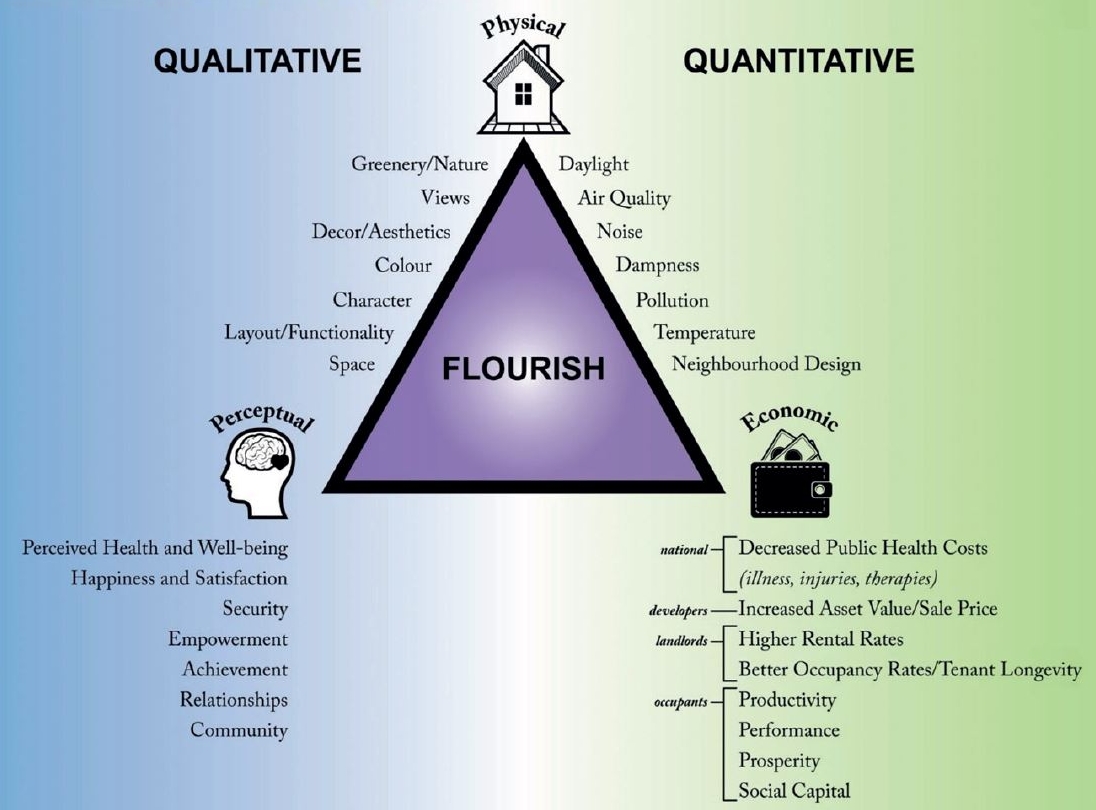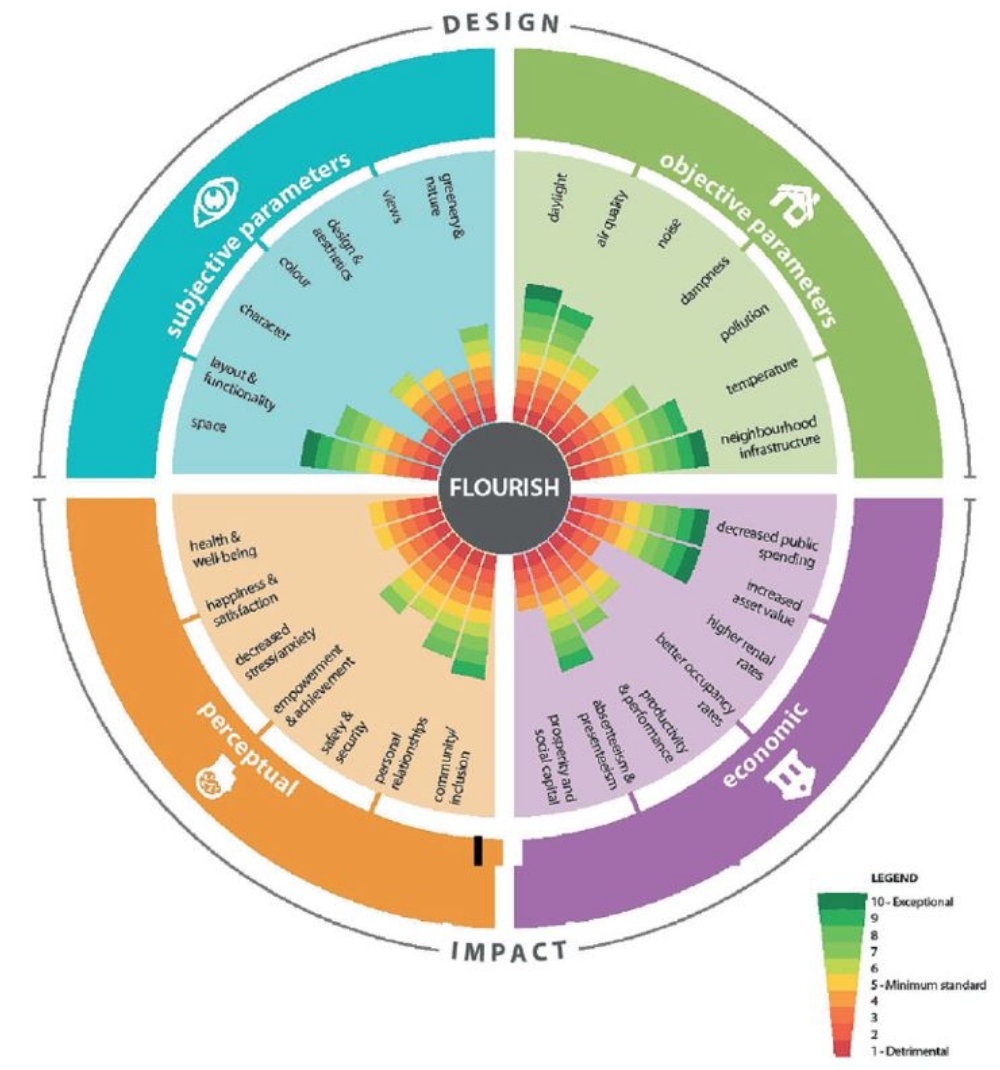The Flourish Model to enhance wellbeing
Professor Derek Clements-Croome from University of Reading takes on a journey underlining the importance of the office environment on employee health and wellbeing.
Contents |
[edit] Introduction
Our expectations of our workplaces are ever-changing, and this requires a change in the way we design our workplaces. Although, traditionally, the cost of occupancy per square metre was the valuation metric, organisations have now realised that employee wellbeing and productivity plays a much more important role in what is considered economic value for money. Therefore, there is now a growing demand for indoor environments that can support health, wellbeing and productivity.

|
| Figure 1: The advantages of using Flourish model for different stakeholders. |
Wellbeing is a complex term which goes beyond environmental comfort. Comfort is usually considered as a pleasant or relaxed state of a human being in relation to their environment. However, that is only part of what we need for the focused and peaceful mind. Outdoors, we enjoy joyful moments such as seeing a tree in blossom, feeling a pleasant air movement or hearing birds singing. Our experience of the outdoor environment is the result of an interplay of heat, light, sound and socio-psychological factors. For indoor environments to support our happiness and wellbeing, they also should provide a multi-sensory experience.
We already have a breadth of knowledge about the sensory response of the human body. Wearable and smart technologies provide us with the opportunity for further enhancing our knowledge of how design decisions affect employees’ physiological and psychological wellbeing, both at the individual and collective level.
[edit] The need to stimulate creativity in the workplace
Creativity is part of human flourishing and needs a physical, mental and social climate to support it. Research in management and leadership explain how different activities can support stimulating creativity. These activities include facilitating collaboration, having success criteria, assigning responsibility, showing how a company cares for employees and allowing employees to arrange their workspace.
In new-build and refurbishment projects, organisations are realising how important it is to engage with the end users at the early design stage in order to better understand their needs and use their feedback to inform better design. This will help the project team deliver a better
indoor environment that can support the end users’ health, happiness and creativity, and, consequently, increase profitability and employee retention. Adopting a Soft Landings approach can enable project teams to engage with the end users, set wellbeing-related success criteria at the beginning of the project and ensure they will be met when the building is completed and in operation.
Employee creativity and productivity depend on motivation, ability and opportunity offered by facilities and support systems. Vitality, which is one of the attributes of positive wellbeing, is about human energy and can be negatively affected by such things as poor indoor air quality, insufficient natural lighting and poor temperature control. Dull environments which lack outdoor views, greenery and colours lead to unstimulating and less creative hours of work no matter how interesting that work might be.
[edit] Development of Derek’s Flourish Model

|
| Figure 2: The Flourish Wheel shows how objective and subjective factors can affect people’s feelings and as a consequence the economics of the workplace. |
The flourish model was developed to help create an environment in which people thrive. The reasoning for this model has been based on the various studies done before on comfort and wellbeing. The model considers the three layers of issues:
- The environmental factors: this is a normal layer featuring standard comfort health and safety guidelines for thermal comfort, noise, light and air quality.
- The perceptions and feelings people have in various environments: this is an individual or proportional layer in which a choice must be made. Usually the decision is made based on the energy efficiency and cost, but potential savings that can happen by better health and productivity must also be considered.
- The sparkle or ‘wow’ layer which includes factors such as access to views on nature, daylight, colour, image, layout and green space around the building.
If we are to create an environment that help people flourish in for living and work, we need to consider all these three layers. Not to do so can have economic consequences such as increased absenteeism and presenteeism.
This article was originally published as by BSRIA in August 2019 here.
--BSRIA
[edit] Related articles on Designing Buildings Wiki
- All about wellness.
- Are we doing the right thing? Shaping well-being into the future of our urban communities.
- Assessing health and wellbeing in buildings.
- Biophilic design.
- BSRIA.
- BSRIA articles on Designing Buildings Wiki.
- Defining the office.
- Human comfort in buildings.
- Internal environment.
- Soft landings.
- TG10 2016 At a glance, wellbeing.
- Thermal comfort and wellbeing.
- Wellbeing and creativity in workplace design - case studies.
- Wellbeing considerations for property managers.
- Wellbeing.
- What we know about wellbeing.
Featured articles and news
RTPI leader to become new CIOB Chief Executive Officer
Dr Victoria Hills MRTPI, FICE to take over after Caroline Gumble’s departure.
Social and affordable housing, a long term plan for delivery
The “Delivering a Decade of Renewal for Social and Affordable Housing” strategy sets out future path.
A change to adoptive architecture
Effects of global weather warming on architectural detailing, material choice and human interaction.
The proposed publicly owned and backed subsidiary of Homes England, to facilitate new homes.
How big is the problem and what can we do to mitigate the effects?
Overheating guidance and tools for building designers
A number of cool guides to help with the heat.
The UK's Modern Industrial Strategy: A 10 year plan
Previous consultation criticism, current key elements and general support with some persisting reservations.
Building Safety Regulator reforms
New roles, new staff and a new fast track service pave the way for a single construction regulator.
Architectural Technologist CPDs and Communications
CIAT CPD… and how you can do it!
Cooling centres and cool spaces
Managing extreme heat in cities by directing the public to places for heat stress relief and water sources.
Winter gardens: A brief history and warm variations
Extending the season with glass in different forms and terms.
Restoring Great Yarmouth's Winter Gardens
Transforming one of the least sustainable constructions imaginable.
Construction Skills Mission Board launch sector drive
Newly formed government and industry collaboration set strategy for recruiting an additional 100,000 construction workers a year.
New Architects Code comes into effect in September 2025
ARB Architects Code of Conduct and Practice available with ongoing consultation regarding guidance.
Welsh Skills Body (Medr) launches ambitious plan
The new skills body brings together funding and regulation of tertiary education and research for the devolved nation.
Paul Gandy FCIOB announced as next CIOB President
Former Tilbury Douglas CEO takes helm.
UK Infrastructure: A 10 Year Strategy. In brief with reactions
With the National Infrastructure and Service Transformation Authority (NISTA).























